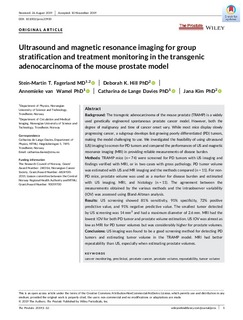| dc.contributor.author | Fagerland, Stein-Martin Tilrum | |
| dc.contributor.author | Hill, Deborah Katherine | |
| dc.contributor.author | van Wamel, Annemieke | |
| dc.contributor.author | Davies, Catharina de Lange | |
| dc.contributor.author | Kim, Jana | |
| dc.date.accessioned | 2020-01-13T08:48:41Z | |
| dc.date.available | 2020-01-13T08:48:41Z | |
| dc.date.created | 2020-01-11T18:54:41Z | |
| dc.date.issued | 2020 | |
| dc.identifier.citation | The Prostate. 2020, 80 186-197. | nb_NO |
| dc.identifier.issn | 0270-4137 | |
| dc.identifier.uri | http://hdl.handle.net/11250/2635851 | |
| dc.description.abstract | Background:The transgenic adenocarcinoma of the mouse prostate (TRAMP) is a widelyused genetically engineered spontaneous prostate cancer model. However, both thedegree of malignancy and time of cancer onset vary. While most mice display slowlyprogressing cancer, a subgroup develops fast‐growing poorly differentiated (PD) tumors,making the model challenging to use. We investigated the feasibility of using ultrasound(US) imaging to screen for PD tumors and compared the performances of US and magneticresonance imaging (MRI) in providing reliable measurements of disease burden.Methods:TRAMP mice (n = 74) were screened for PD tumors with US imaging andfindings verified with MRI, or in two cases with gross pathology. PD tumor volumewas estimated with US and MR imaging and the methods compared (n = 11). For non‐PD mice, prostate volume was used as a marker for disease burden and estimatedwith US imaging, MRI, and histology (n = 11). The agreement between themeasurements obtained by the various methods and the intraobserver variability(IOV) was assessed using Bland‐Altman analysis.Results:US screening showed 81% sensitivity, 91% specificity, 72% positivepredictive value, and 91% negative predictive value. The smallest tumor detectedby US screening was 14 mm3and had a maximum diameter of 2.6 mm. MRI had thelowest IOV for both PD tumor and prostate volume estimation. US IOV was almost aslow as MRI for PD tumor volumes but was considerably higher for prostate volumes.Conclusions:US imaging was found to be a good screening method for detecting PDtumors and estimating tumor volume in the TRAMP model. MRI had betterrepeatability than US, especially when estimating prostate volumes. | nb_NO |
| dc.language.iso | eng | nb_NO |
| dc.publisher | Wiley | nb_NO |
| dc.rights | Attribution-NonCommercial-NoDerivatives 4.0 Internasjonal | * |
| dc.rights.uri | http://creativecommons.org/licenses/by-nc-nd/4.0/deed.no | * |
| dc.title | Ultrasound and magnetic resonance imaging for group stratification and treatment monitoring in the transgenic adenocarcinoma of the mouse prostate model | nb_NO |
| dc.type | Journal article | nb_NO |
| dc.type | Peer reviewed | nb_NO |
| dc.description.version | publishedVersion | nb_NO |
| dc.source.pagenumber | 186-197 | nb_NO |
| dc.source.volume | 80 | nb_NO |
| dc.source.journal | The Prostate | nb_NO |
| dc.identifier.doi | 10.1002/pros.23930 | |
| dc.identifier.cristin | 1770743 | |
| dc.relation.project | Norges forskningsråd: 240316 | nb_NO |
| dc.description.localcode | This is an open access article under the terms of the Creative Commons Attribution‐NonCommercial‐NoDerivs License, which permits use and distribution in any medium, provided the original work is properly cited, the use is non‐commercial and no modifications or adaptations are made. © 2019 The Authors. The Prostate Published by Wiley Periodicals, Inc. | nb_NO |
| cristin.unitcode | 194,65,25,0 | |
| cristin.unitcode | 194,66,20,0 | |
| cristin.unitname | Institutt for sirkulasjon og bildediagnostikk | |
| cristin.unitname | Institutt for fysikk | |
| cristin.ispublished | true | |
| cristin.fulltext | original | |
| cristin.qualitycode | 1 | |

